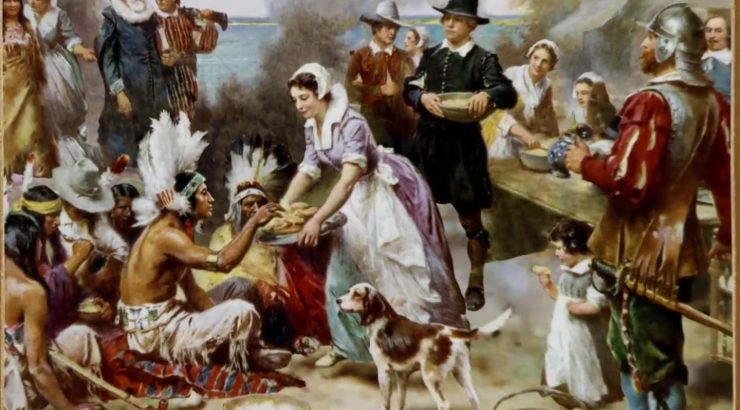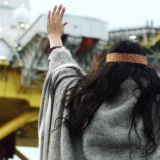
Thanksgiving is a Complex Holiday
November 20, 2020

Circa 1700, Engraving, after a painting by Baron Wappers, of the passengers of the Mayflower in America. (Photo by Three Lions/Getty Images)
When it comes to the history of Thanksgiving, the mainstream version goes like this – white settlers on the Mayflower that landed near Plymouth Rock in Massachusetts in 1620 were greeted by a friendly Wampanoag tribe, who had lived there for thousands of years prior. The Wampanoag tribe taught the new settlers how to catch fish, plant vegetables and prepare food. A year later, when the Pilgrim’s crops proved successful, a gathering was arranged between the tribe and the settlers and together they celebrated with a three-day long feast, which some called the first Thanksgiving.
Today, it’s a holiday where families and friends get together for a big turkey meal and an array of side dishes, such as stuffing, roasted vegetables and pumpkin pie, to give thanks, but what historical event are we actually commemorating?
According to nativehope.org, to many Native Americans, Thanksgiving is a day of mourning and protest since it commemorates the arrival of settlers in North America and the centuries of oppression and genocide that followed. The massacres of Native tribes like the Pequot and how some white settlers robbed Wampanoag graves and stole their food is rarely mentioned.
“Thanksgiving day is a reminder of the genocide of millions of Native people, the theft of Native lands, and the relentless assault on Native culture. Participants in National Day of Mourning honor Native ancestors and the struggles of Native peoples to survive today. It is a day of remembrance and spiritual connection as well as a protest of the racism and oppression which Native Americans continue to experience,” – United American Indians of New England.
Thirty years ago in 1990, President George H.W. Bush declared November as “National Native American Heritage Month.” This month is designated for the people of our country to celebrate and recognize the accomplishments of those who were the original inhabitants and settlers of the United States.
This is also a time for Americans to stop and reflect, listen, and learn about the history of American Indians and the challenges these tribes and families faced many years ago and still face today.
Organizations such as nativepartnership.org and nativehope.org are working to educate people about Native American history and “dismantle barriers through storytelling and impactful programs to bring healing and inspire hope.”
“It is important for all of us to understand the rich culture, tradition, and history of Native Americans and their status today, and to appreciate the contributions that First Americans have made and will continue to make to our Nation.” – President Barack Obama – 2009.
“Understanding the complexity of history, for example, an indigenous perspective of thanksgiving, is one of the reasons ethnic studies is so important to a holistic understanding of our past. We need as complete a story as possible, inclusive of as many experiences as possible, to help educate critical thinkers for a global age,” said Stephanie Takaragawa, Associate Professor of Sociology, Associate Dean of Wilkinson College of Arts, Humanities, and Social Sciences.
Yes, Thanksgiving is a time to express gratitude for what you have and a time to gather with family, but this year, on Thursday, November 26, 2020, take the time to talk with loved ones about the possibilities of a world with no barriers. Talk about the good, the bad and the ugly that occurred over two centuries ago in North America, because it is all important to understand. The history of our Nation continues to affect Native communities, and now more than ever, is the time to reflect, listen, and learn – and start making a change.

